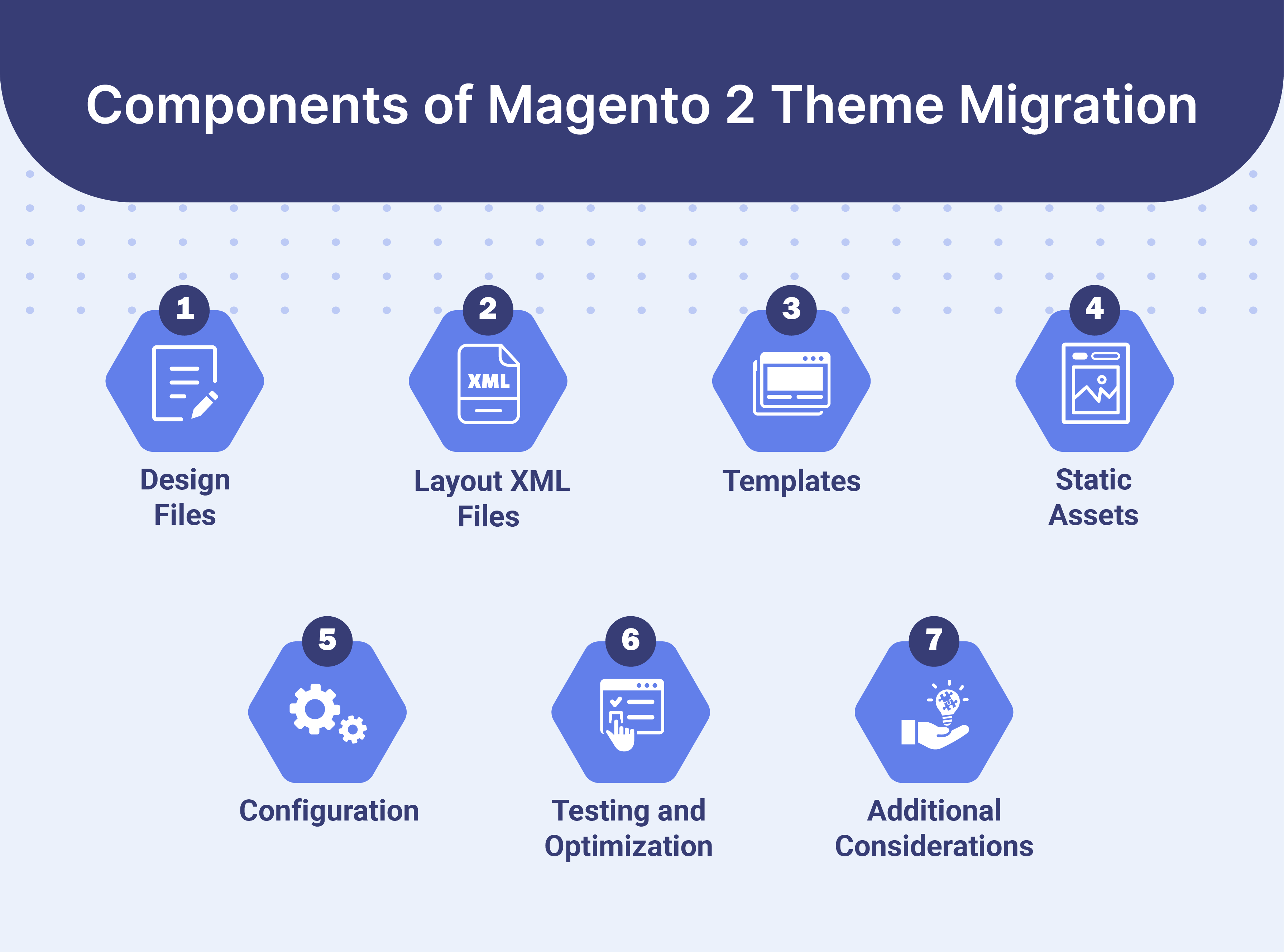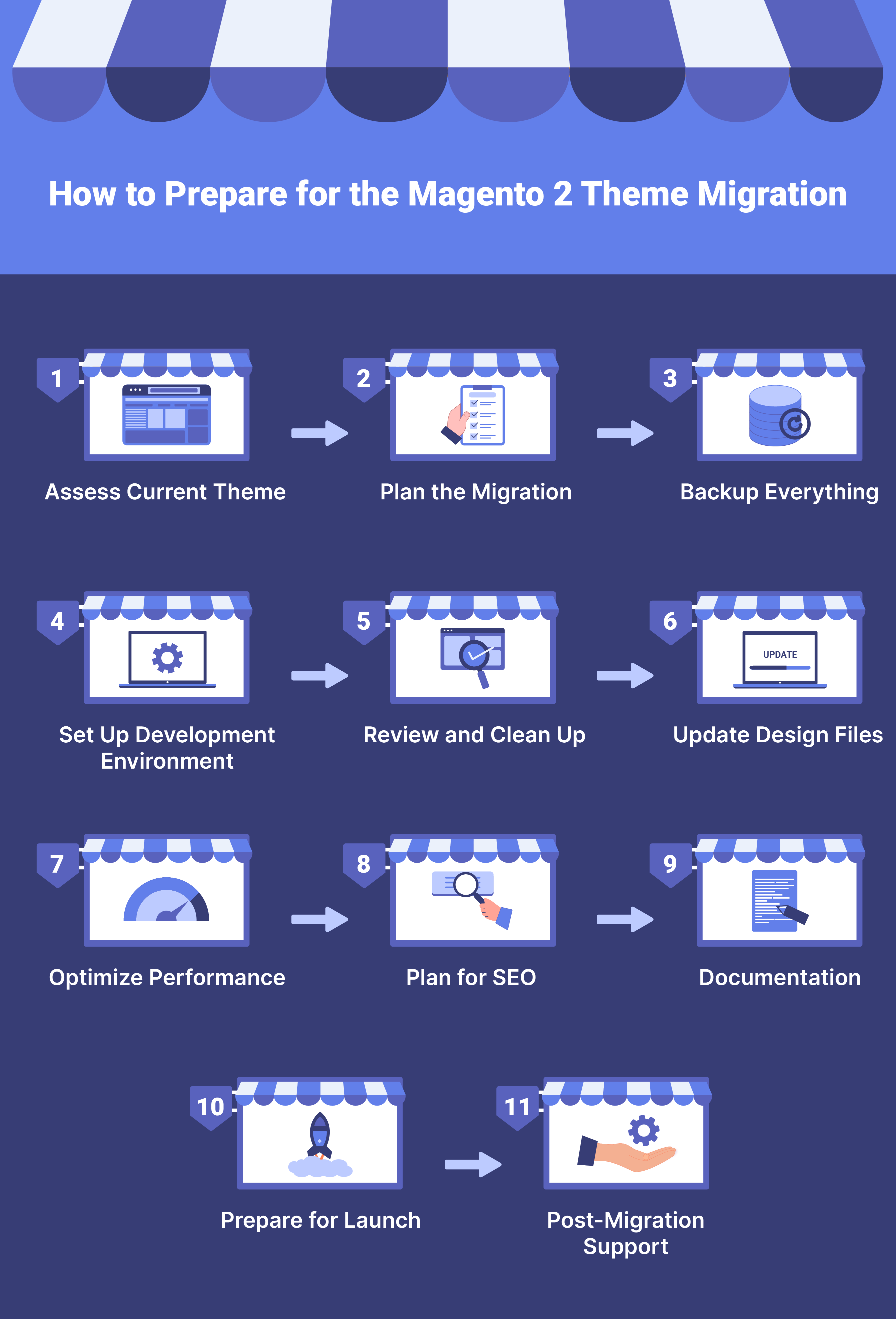
Magento 2 Theme Migration: Components and Preparation Steps
Want to ensure a smooth Magento 2 theme migration for your Magento store? The process of transferring a theme ensures compatibility with the new platform's architecture. In this article, we will explore the steps involved, benefits, and components of Magento 2 theme migration.
Key Takeaways
-
Understand what Magento 2 theme migration is and why it's important.
-
Learn the steps involved in a smooth theme migration process.
-
Discover the essential components of Magento 2 theme migration.
-
Get tips on how to prepare and plan for the migration.
-
Explore the benefits of migrating to Magento 2, including improved performance and security.
What is Magento 2 Theme Migration?
Magento 2 theme migration involves transferring a theme from Magento 1 to Magento 2. The Magento 1 to Magento 2 migration process is not a simple copy-paste task. This is due to the structural and technological differences between the two versions.
It includes redesigning and redeveloping the theme to align with Magento 2's architecture. It ensures compatibility with new features and functionalities.
The migration process typically involves:
-
Exporting and converting design files
-
Customizing templates, styles, and layouts
-
Thoroughly testing the theme.
Proper migration ensures a smooth transition. It helps maintain the site's visual appeal and user experience while leveraging the improved performance and features of Magento 2.
Components of Magento 2 Theme Migration

1. Design Files
Migrating design files involves updating:
-
CSS
These should be aligned with the structure of Magento 2. It includes:
-
Refactoring HTML for accessibility
-
Converting CSS to LESS or Sass
-
Adapting JavaScript to use RequireJS.
These updates ensure compatibility and improved performance.
2. Layout XML Files
The migration of layout XML files requires converting the Magento 1 configuration to Magento 2’s format. It involves rewriting XML files to define page layouts and block structures according to Magento 2 conventions. Proper handling of layout inheritance streamlines customization and maintenance.
3. Templates
Updating PHTML template files ensures compatibility with Magento 2’s templating system. The process includes updating template syntax and replacing deprecated PHP functions. Modernizing templates helps maintain functionality and performance.
4. Static Assets
Migrating static assets involves transferring and optimizing images, fonts, and other media. It involves image optimization and correct linking of custom fonts. Magento 2’s static content deployment tools streamline asset delivery. It ensures visual appeal and performance.
5. Configuration
Customizing theme settings and configurations for Magento 2 includes updating:
-
Color schemes
-
Typography
-
Bespoke settings.
Utilizing Magento 2's advanced styling options enhances the design. It ensures all configurations align with the new platform’s capabilities.
6. Testing and Optimization
Conduct thorough testing in the staging environment. Comprehensive testing and optimization involve cross-device and cross-browser testing. It helps ensure responsiveness and functionality. Thorough testing guarantees a smooth user experience. Perform user acceptance testing (UAT) to validate that the theme meets business requirements.
7. Additional Considerations
Additional factors include:
-
Ensuring extension compatibility
-
Maintaining SEO and URL management
-
Enhancing user experience.
Migrating or replacing extensions and leveraging Magento 2’s advanced features help in successful migration.
How to Prepare for the Magento 2 Theme Migration

1. Assess Current Theme
Analyze the current Magento 1 themes:
-
Design
-
Features
-
Customizations.
Identify essential elements that need to be preserved. You should also identify any outdated aspects that could be improved or eliminated in the new theme.
2. Plan the Migration
Create a detailed migration plan that outlines each step of the migration process, including:
-
Steps
-
Resource allocation
-
Timeline.
Include a risk management plan to address potential issues that may arise during the migration process. These ensure a smooth transition.
3. Backup Everything
Before starting the migration, back up all data, including:
-
Current theme
-
Any custom code.
It ensures you can restore the original state if anything goes wrong during the migration.
4. Set Up Development Environment
Establish a staging environment that replicates the live site. It allows for testing, development, and migration without affecting the live site’s performance and availability. It ensures all changes work correctly before deployment.
5. Review and Clean Up
Before starting the Magento 2 theme migration, you should conduct a thorough review and clean-up of your current store. It includes:
-
Review your current theme
-
Identify outdated or unused elements
-
Clean up the code.
These steps reduce complexity and potential issues during migration.
6. Update Design Files
-
Ensure all design files are up-to-date and ready for migration.
-
Refactor HTML, CSS, and JavaScript files to align with Magento 2’s requirements.
-
Utilize modern design practices and tools to ensure compatibility and performance.
7. Optimize Performance
Implement performance optimization techniques. Performance optimization, such as full-page caching, ensures fast load times. Code minification ensures the theme loads quickly and efficiently. Image optimization ensures a better user experience.
8. Plan for SEO
Ensure that SEO settings and URL structures are preserved during the migration. Use Magento tools to check for broken links. You should also ensure that search engine rankings are not negatively affected.
9. Documentation
Keep detailed documentation of the Magento migration process, including:
-
Changes made
-
Issues encountered
-
Solutions implemented.
It helps in troubleshooting and future migrations.
10. Prepare for Launch
Perform final checks to ensure everything is in place. Plan the launch carefully to minimize downtime and disruptions. Schedule the launch during off-peak hours. You should also ensure that all stakeholders are prepared for the transition. Once satisfied with the testing, deploy the migrated theme to the live site.
11. Post-Migration Support
After the Magento 2 migration, closely monitor the site for any issues. Provide support to address any problems that users encounter. You should also make necessary adjustments to optimize performance and functionality.
Why You Should Consider Magento 2 Theme Migration Steps
1. Improved Performance
Magento 2 is designed with performance in mind. It offers improved speed and efficiency. Features like full-page caching and optimized code contribute to faster load times. It enhances user experience and boosts search engine rankings.
2. Enhanced Security
Magento 2 includes advanced security features to protect your new Magento 2 store from vulnerabilities. Regular security patches and updates ensure that your site remains secure against threats. It provides peace of mind for you and your customers.
3. Better User Experience
Magento 2 themes are built to be fully responsive. These ensure a smooth experience across all devices. Enhanced design capabilities allow for more engaging and intuitive interfaces. It can improve customer satisfaction and increase conversions.
4. Advanced Features
Magento 2 supports a wide range of modern e-commerce features, such as:
-
Personalized content
-
Integrated payment gateways.
These features enhance the functionality of your store, making it more competitive in the Magento marketplace.
5. Scalability
Magento 2 is designed to scale with your business. Whether you’re handling a small catalog or a large, complex one, Magento 2 can support your growth. It comes with powerful infrastructure and flexible architecture.
6. Streamlined Checkout Process
Magento 2 offers a more streamlined and user-friendly checkout process. It reduces cart abandonment rates. A simplified checkout can lead to higher conversion rates and better sales performance.
7. Improved Admin Interface
The admin interface in Magento 2 is more intuitive and user-friendly compared to Magento 1. It offers an enhanced data migration tool to manage:
-
Products
-
Orders
-
Customers.
It improves the efficiency of your store management.
8. Better Development Tools
Magento 2 provides a more advanced and efficient development environment. Features like modular architecture and improved testing tools make it easier for developers to:
-
Build
-
Customize
-
Maintain the site.
9. Community and Support
Magento 2 has a vibrant and active community of developers, partners, and users. The community provides a wealth of resources, extensions, and support. It helps you to overcome challenges and stay updated with the latest trends.
10. Competitive Advantage
Migrating to Magento 2 ensures that your Magento 1 store remains competitive in the fast-evolving e-commerce landscape. It allows you to leverage the latest technologies and innovations. It provides a better shopping experience for your customers.
FAQs
1. How do I migrate my theme from Magento 1 to Magento 2?
To migrate from Magento 1, first, ensure your theme is compatible with Magento 2. Install the data migration tool to transfer data, then manually recreate the theme elements.
2. Is my Magento 1 theme compatible with Magento 2?
Magento 1 themes are not directly compatible with Magento 2. You need to rebuild the theme to fit the new Magento 2 framework when you migrate from Magento 1.
3. What is the role of the data migration tool in migration for Magento 1 and Magento 2?
The data migration tool helps migrate Magento 1 store data to Magento 2 but doesn't migrate themes. Use it to transfer data, then focus on theme compatibility with Magento 2.
4. Can I keep some design elements from my Magento 1 theme when migrating to Magento 2?
You can keep design concepts when you migrate from Magento 1, but they must be rebuilt to be compatible with Magento 2. Install the data migration tool for data transfer.
Summary
Magento 2 theme migration enhances your store's performance, security, and user experience. The article uncovers several other points, including:
-
Components of Magento 2 theme migration include updating design files and modernizing templates.
-
Thorough testing and optimization ensure responsiveness and functionality across devices.
-
Proper preparation involves assessing the current theme, planning the migration, and preserving SEO settings.
-
The benefits of migrating include improved speed and better user experience.
Ready to elevate your store with Magento 2 theme migration? Experience smooth performance and enhanced security with managed Magento hosting.



